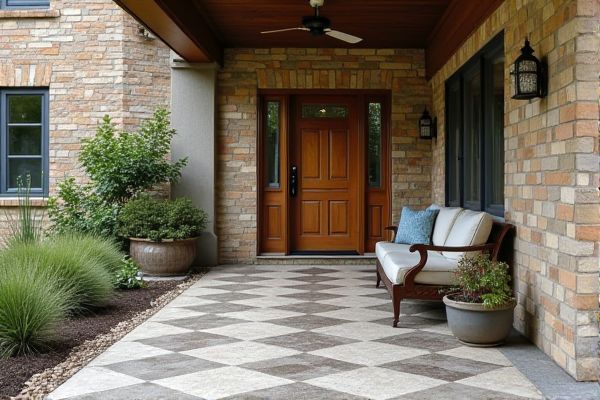
Choosing between mosaic tiles and stamped concrete for your porch depends on factors like aesthetic preference, durability, and maintenance requirements; mosaic tiles offer intricate designs and vibrant colors but may require more upkeep, while stamped concrete provides a cost-effective, durable surface with customizable patterns mimicking natural materials. Explore the full article to discover which option best suits your porch needs and enhances your outdoor space.
Table of Comparison
| Feature | Mosaic Tiles | Stamped Concrete |
|---|---|---|
| Appearance | Colorful, patterned, artistic designs | Customizable textures and patterns mimicking natural materials |
| Durability | High resistance to wear and weather | Strong, weather-resistant, may crack over time |
| Installation | Labor-intensive, requires skilled workmanship | Faster installation, requires proper curing |
| Maintenance | Easy maintenance, occasional grout cleaning | Needs sealing every few years, repair if cracked |
| Cost | Higher material and labor cost | More affordable, cost-effective for large areas |
| Slip Resistance | Generally good with textured tiles and grout | Can be slippery when wet unless textured sealers are applied |
| Lifespan | 20-50 years with proper care | 15-30 years depending on maintenance |
Introduction: Mosaic Tiles vs Stamped Concrete for Porches
Mosaic tiles offer intricate designs and vibrant color options that can elevate porch aesthetics with a durable, slip-resistant surface ideal for outdoor use. Stamped concrete provides a cost-effective solution mimicking natural materials like stone or brick, ensuring a seamless and low-maintenance finish. Both options deliver unique visual appeal and long-lasting performance tailored to different architectural styles and budget requirements.
Aesthetic Appeal: Patterns and Styles
Mosaic tiles on your porch offer intricate patterns and vibrant styles that create a visually captivating, customizable aesthetic. Stamped concrete mimics natural textures like stone or brick, providing a durable surface with elegant, uniform designs. Both options enhance curb appeal, but mosaic tiles deliver more artistic detail while stamped concrete ensures seamless patterns.
Durability and Longevity
Mosaic tiles offer high durability with resistance to cracking and fading, maintaining their aesthetic appeal over decades with proper sealing and maintenance. Stamped concrete provides strong longevity and can withstand heavy foot traffic and weather conditions, though it may require periodic resealing to prevent surface wear and cracking. Both materials can last 20-30 years or more depending on climate and care, but mosaic tiles generally offer superior resistance to surface damage.
Installation Process and Time
Mosaic tile installation on porches involves precise layout planning, cutting tiles to fit, and applying adhesive followed by grout, typically requiring 2 to 4 days depending on the area and complexity. Stamped concrete installation includes pouring a concrete slab, applying texture mats and color stains within 2 to 3 days, allowing for curing time that can extend the total project timeline to about a week. Mosaic tiles demand meticulous workmanship and longer drying time, while stamped concrete provides a faster, more uniform surface with less detailed labor intensity.
Maintenance Requirements
Mosaic tiles require regular cleaning and occasional grout sealing to prevent mold and staining, ensuring long-lasting vibrancy on your porch surface. Stamped concrete demands periodic resealing every 2-3 years to protect against weathering, cracking, and color fading. You should consider the time and cost involved in maintaining each option to keep your porch looking pristine.
Cost Comparison
Mosaic tiles for porches generally incur higher upfront costs due to intricate design work and premium materials, often ranging between $15 to $30 per square foot. Stamped concrete typically costs less, averaging $8 to $18 per square foot, making it a budget-friendly option for achieving decorative finishes. Your choice depends on balancing initial investment with desired aesthetics and long-term maintenance expenses.
Slip Resistance and Safety
Mosaic tiles provide superior slip resistance on porches due to their textured surface and grout lines, which enhance traction even when wet. Stamped concrete, while visually appealing, often requires sealers or additives to improve slip resistance and prevent slippery conditions during rain or ice. Prioritizing slip-resistant finishes on either material is essential to ensure maximum safety and reduce fall hazards on porch surfaces.
Weather and Climate Suitability
Mosaic tiles offer superior resistance to weather elements such as rain and UV exposure, making them ideal for porches in diverse climates including hot, humid, and coastal regions. Stamped concrete can be susceptible to cracking and fading under extreme temperature fluctuations and is best suited for moderate climates with proper sealing and maintenance. Selecting between mosaic tiles and stamped concrete depends heavily on the local climate's impact on material durability and maintenance frequency.
Customization Options
Mosaic tiles offer extensive customization options with a wide variety of colors, patterns, and materials, allowing for intricate and personalized porch designs. Stamped concrete provides versatile surface patterns and textures that replicate natural stone, brick, or wood, but customization is generally limited to color choice and stamping molds. The ability of mosaic tiles to create detailed and unique artwork surpasses that of stamped concrete, making them ideal for highly customized porch aesthetics.
Environmental Impact
Mosaic tiles are generally more environmentally friendly than stamped concrete due to their use of recycled materials and lower carbon footprint in production. Stamped concrete requires significant energy consumption and emits higher levels of CO2 during cement manufacturing, contributing to environmental degradation. Choosing mosaic tiles can reduce resource depletion and minimize ecological harm in porch construction.
 homyna.com
homyna.com